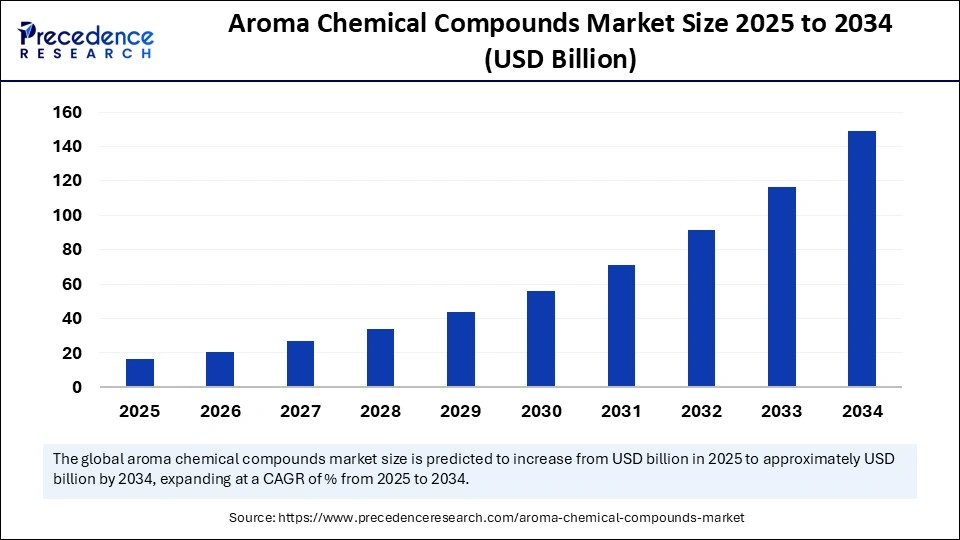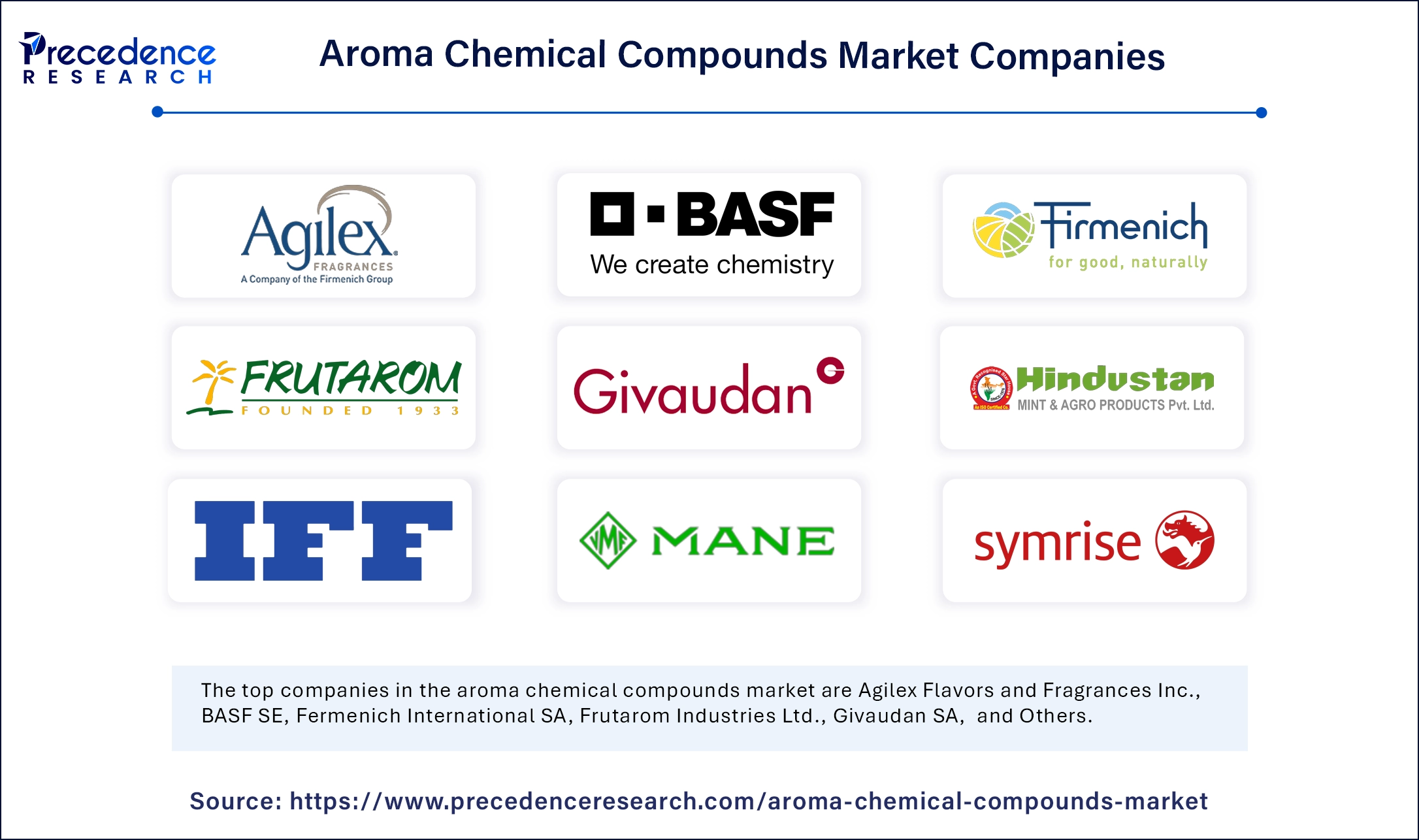January 2025
The aroma chemical compounds market refers to the global industry focused on the production and distribution of synthetic and natural aroma compounds used in fragrances, flavors, cosmetics, and personal care products. The market sizing and forecasts are revenue-based (USD Million/Billion), with 2024 as the base year
The aroma chemical compounds market involves the production of scent ingredients used in perfumes, cosmetics, and flavors, driven by demand for unique and natural aromas. The market growth is attributed to the rising demand for sustainable, natural aroma compounds across personal care, food, and household applications.

Artificial Intelligence (AI) accelerate both aroma chemical compound research and their creation to rapid commercialization. AI helps in identifying new compounds. AI-driven tools help study chemical compositions, enabling researchers and manufacturers develop new formulations. AI technology enables manufacturers to discover optimal formulations more rapidly with improved accuracy. Moreover, AI can optimize production processes by automating tasks like material scheduling, handling, and quality control.
The aroma chemical compounds market is witnessing rapid growth due to the rising demand for fragrances. Consumers are increasingly seeking ingredients that are natural and sustainable. There is a high demand for environmentally friendly, plant-based products, which compels manufacturers to develop aroma compounds that are derived from natural sources. The European Chemicals Agency (ECHA), together with the U.S. Environmental Protection Agency (EPA), released new guidance about safe chemicals in 2024. This prioritized bio-based aroma compounds for reducing dangerous waste products. Furthermore, the regulatory approvals for bio-based compounds create conditions that lead to wider acceptance in various industries, further propelling the growth of the market.
| Report Coverage | Details |
| Dominating Region | North America |
| Fastest Growing Region | Asia Pacific |
| Base Year | 2024 |
| Forecast Period | 2025 to 2034 |
| Segments Covered | Type, Source, Application, and Region |
| Regions Covered | North America, Europe, Asia-Pacific, Latin America, and Middle East & Africa |
Increasing Demand for Natural and Sustainable Ingredients
Increasing consumer preference for eco-friendly and plant-based products is a key factor driving the growth of the aroma chemical compounds market. The rising popularity of natural fragrances further supports market growth. The U.S. Food and Drug Administration (FDA) issued a new cosmetic labeling doctrine in 2024, which compels manufacturers to reveal fragrant ingredients and use safe and natural raw elements. The development of sustainable ingredients substitutes synthetic resources relies on both biotechnological methods and green chemical science. The industry is transitioning to sustainability by creating effective aromatic compounds that meet product requirements. The World Health Organization (WHO) underlined product chemical exposure reduction in 2024, as synthetic substances might cause allergic reactions and respiratory issues in consumers. Moreover, the rising health consciousness among consumers is driving the demand for natural aroma chemical solutions, boosting the growth of the market.
Health Risks Associated with Synthetic Aroma Chemicals
Increasing scrutiny surrounding the health and safety of synthetic aroma chemicals is projected to hinder the growth of the aroma chemical compounds market. Scientists discovered that phthalates and synthetic musks cause allergic reactions to the body. Regulatory authorities, including the U.S. Environmental Protection Agency (EPA) and European Chemicals Agency (ECHA), conducted a stricter assessment of widespread synthetic materials in 2024 to address potential health and environmental risks. Furthermore, the need for complete disclosure and non-chemical products affects both product formulation strategies and long-term development, thus hindering the market.
Increasing Investments in Green Chemistry and Biotechnological Advancements
Increasing investments in green chemistry and a strong emphasis on biotech-driven synthesis techniques are likely to create immense opportunities for key players operating in the aroma chemical compounds market. Green chemistry promotes the development of bio-based aroma chemical compounds derived from plants and microorganisms. CRISPR and microbial fermentation technologies enable industry players to produce unique aroma compounds. These manufacturing methods lower waste production while reducing dependence on natural materials. Furthermore, in 2024, the National Institutes of Health (NIH) declared that synthetic biology approaches, which include enzyme optimization and cell-free biosynthesis, enhance the production of safer and cleaner ingredients.
The benzenoids segment dominated the aroma chemical compounds market in 2024. This is mainly due to their extensive use in perfumes, personal care products, and flavor formulations. These chemical compounds provide high stability with strong aromatic properties, so manufacturers use them in various mixture formulations. Moreover, synthetic benzenoids are in high demand, as they serve the worldwide need for inexpensive, lasting scents without using precious plant species.
The synthetic segment held the largest share of the aroma chemical compounds market in 2024. This is mainly due to the cost-effectiveness, high availability, and versatility of synthetic aroma chemical compounds. Synthetic compounds provide diverse aromatic ranges, making them suitable for various cosmetic applications. Additionally, they provide long-lasting aromas with extended shelf life, making them suitable for large-scale production of fragrances.
The natural segment is projected to expand at the fastest rate in the coming years. The growth of the segment can be attributed to the rising consumer preferences for plant-based, sustainable products. People are becoming more aware of the environmental impact and health implications linked to synthetic chemicals. This, in turn, boosts the demand for natural aroma chemical compounds. Consumers in North America and Europe increasingly prioritize natural ingredients. The rising demand for natural fragrances is likely to contribute to segmental growth.
The personal care & cosmetics segment led the aroma chemical compounds market with the largest share in 2024. This is mainly due to the increased consumer demand for scented skincare, haircare, and grooming products. Leading cosmetic brands developed new fragrance collections and aromatherapeutic solutions to satisfy customer desires. Additionally, with the expansion of middle-class populations across emerging economies, spending on personal care has increased, boosting the demand for premium, long-lasting fragrances.
The food & beverages segment is expected to grow at a rapid pace during the forecast period. The growth of the segment can be attributed to the increasing demand for food flavors. Food & beverage manufacturers employ aroma chemicals to enhance taste, sensory appeal, and overall quality. Aroma compounds are used as a preservative to improve shelf life and quality of food items. The rising demand for packaged food products is expected to drive the growth of the segment in the coming years.
The U.S. Food and Drug Administration (FDA) maintained its regulatory stance regarding flavoring agent safety in 2024. It enabled revolutionary advancements in aroma-based solutions for food.
North America registered dominance in the aroma chemical compounds market by capturing the largest share in 2024. The region’s dominance is mainly attributed to the heightened consumer demand for natural ingredients. There is also a high demand for fragrances in various industries, such as food & beverages and personal care & cosmetics. The U.S. is a major contributor to the market in North America. There is an increasing demand for plant-based personal care ingredients, including aroma compounds. Fragrances and cosmetic manufacturers are prioritizing natural ingredients to fulfill consumers' demands.
Asia Pacific is anticipated to witness the fastest growth in the market during the forecast period, owing to the increasing adoption of scented personal care products and household goods. The preference for packaged food items is rising in countries like China, India, and Japan, driving the demand for aromatic food ingredients. Governments around the region are also promoting the use of natural ingredients, contributing to market growth. For instance, China’s National Mission on Bioeconomy and Five-Year Plans for Green Development focuses on sustainable chemical manufacturing, leading to the rapid development of natural aroma chemical compounds. With the increasing consumer disposable income, spending on high-quality products with fragrances is rising, supporting market expansion.
Europe is expected to witness notable growth in the coming years. The growth of the European aroma chemical compounds market can be attributed to the rising demand for fragrances and the increasing adoption of premium aromatic items. The region is home to some leading market players, including Givaudan, Firmenich, and Symrise, facilitating high production capabilities and innovation in aroma compounds. With a strong emphasis on sustainable practices, there is a high demand for natural fragrances and skincare products, boosting the need for natural aroma compounds. In addition, the rising demand for high-quality fragrances contributes to regional market growth.

By Type
By Source
By Application
By Region
For inquiries regarding discounts, bulk purchases, or customization requests, please contact us at sales@precedenceresearch.com
No cookie-cutter, only authentic analysis – take the 1st step to become a Precedence Research client
January 2025
March 2025
January 2025
September 2024